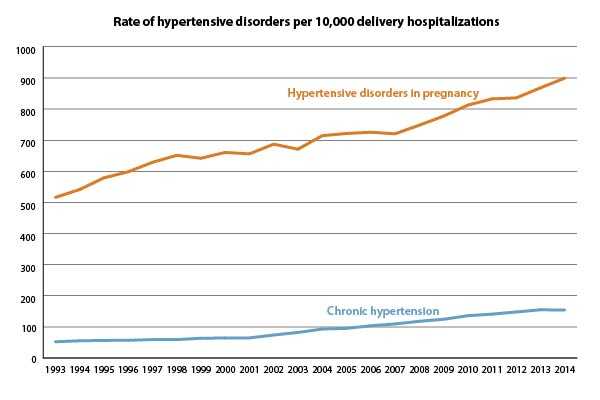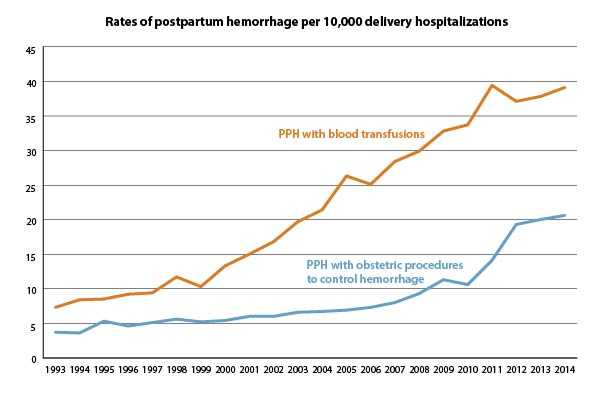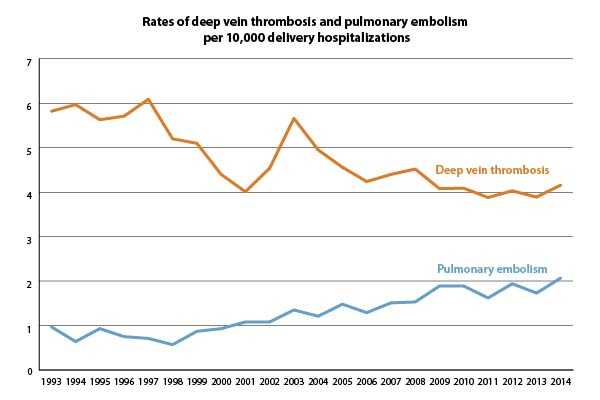Data on Selected Pregnancy Complications in the United States
Pregnancy complications may be caused by conditions women have before pregnancy or conditions women develop during pregnancy. The impact of pregnancy complications on maternal and neonatal outcomes is difficult to estimate because pregnancy complications are made up of a broad range of conditions with varying levels of severity. The following figures show trends over time from 1993 through 2014 of three potentially serious, but preventable, pregnancy complications using data from the National Inpatient Sample. Understanding rates and trends in these data can be used to identify opportunities to prevent and manage pregnancy complications and improve care for pregnant women.
Hypertensive Disorders, 1993-2014

This figure shows the rate of hypertensive disorders per 10,000 delivery hospitalizations from 1993 through 2014. Women can develop high blood pressure, also known as hypertension, before or during pregnancy.
Hypertensive disorders in pregnancy include
- Gestational hypertension (high blood pressure that develops during pregnancy).
- Preeclampsia (high blood pressure and signs of problems with the kidneys, liver, and other organs).
- Eclampsia (preeclampsia and seizures without other prior health problems, such as epilepsy).
Chronic hypertension refers to hypertension developed before pregnancy.
Throughout the years, hypertensive disorders in pregnancy were more common than chronic hypertension. The rate of hypertensive disorders in pregnancy increased substantially over the years, from 528.9 in 1993 to 912.4 in 2014. The rate of chronic hypertension also increased considerably over time, from 65.1 in 1993 to 166.9 in 2014.
Postpartum Hemorrhage, 1993-2014*

This figure shows the rate of postpartum hemorrhage (PPH) per 10,000 delivery hospitalizations from 1993 through 2014. Postpartum hemorrhage is when a woman has heavy bleeding after delivery.
PPH with obstetric procedures to control hemorrhage include
- Surgical repair of a deep cut or tear of the uterus.
- Uterine artery ligation/embolization (tying off the vessel or identifying and injecting material into the bleeding vessel).
- Obstetric tamponade of uterus or vagina (packing with gauze or using a medical device).
- Hysterectomy (surgery to remove the uterus).
PPH with blood transfusions is when a patient with PPH is given donated blood.
The rate of PPH with procedures to control hemorrhage increased from 4.3 in 1993 to 21.2 in 2014, with sharper increases in later years. The rate of PPH with blood transfusions also increased noticeably over time, from 7.9 in 1993 to 39.7 in 2014.
*Obstetric procedures to control PPH and blood transfusion were coded hierarchically, meaning that only blood transfusions were used to control PPH for the blood transfusion group, while procedures with or without blood transfusion could be used for the obstetric procedure group.
Deep Vein Thrombosis and Pulmonary Embolism, 1993-2014

This figure shows the rate of deep vein thrombosis and pulmonary embolism per 10,000 delivery hospitalizations from 1993 through 2014. Deep vein thrombosis is a condition that happens when a blood clot forms in a deep vein. These clots typically develop in the lower leg, thigh, or pelvis. The most serious complication of deep vein thrombosis is when part of the clot breaks off and travels to the lungs, causing a blockage called pulmonary embolism.
The rate of deep vein thrombosis fluctuated through the years, but overall, decreased from 5.9 in 1993 to 4.3 in 2014. The rate of pulmonary embolism doubled over time, from 1.1 in 1993 to 2.2 in 2014.
ICD-9-CM Codes
The following International Classification of Diseases, Ninth Revision, Clinical Modification (ICD-9-CM) codes are used to identify delivery hospitalizations with selected complications from the 1994-2013 National Inpatient Sample.
Table: ICD-9-CM Codes
| Maternal Morbidity Indicator | ICD-9-CM Codes | ICD-9-CM Diagnosis Code | ICD-9-CM Procedure Code | Special notes |
|---|---|---|---|---|
| Chronic hypertension | 642.0x, 642.1x, 642.2x, 642.7x, 401.x, 402.x, 403.x, 404.x, 405.x | x | ||
| Hypertensive disorder in pregnancy (Gestational hypertension, mild pre-eclampsia, eclampsia/severe pre-eclampsia, unspecified) | 642.3x, 642.4x, 642.5x, 642.6x, 642.9x | x | ||
| Blood transfusion | 99.0x | x | ||
| Obstetric procedures to control postpartum hemorrhage | Hysterectomy Obstetric tamponade of uterus or vagina Repair of current obstetric laceration of uterus Uterine artery ligation/embolization |
|||
| Hysterectomy | ‘683’, ‘6831’, ‘6839’, ‘684’, ‘6841’, ‘6849’, ‘685’, ‘6851’, ‘6859’, ‘686’, ‘6861’, ‘6869’, ‘687’, ‘6871’, ‘6879’, ‘689’ |
x | ||
| Obstetric tamponade of uterus or vagina | ‘758’ | x | ||
| Repair of current obstetric laceration of uterus | ‘7550’, ‘7552’ | x | ||
| Uterine artery ligation/embolization | ‘3979’*, ‘9929’*, ‘6825’**, ‘6824’** | x | *Introduced in 2002 **Introduced in 2011 |
|
| Pulmonary embolism | 415.1x, 673.2 | x | ||
| Deep venous thrombosis | 4534, 453.5x, 453.7x, 453.8x, 453.9x, 671.3x, 671.4x, 9972 | x |
- Page last reviewed: August 8, 2017
- Page last updated: August 8, 2017
- Content source:


 ShareCompartir
ShareCompartir